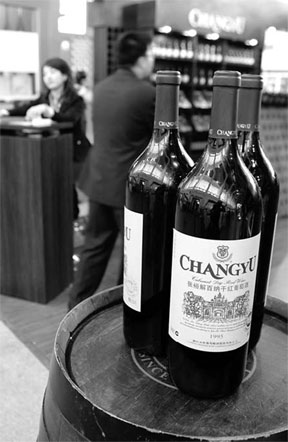

If you want to know what all the fuss is about "Jiebaina", looking back on the history of Chinese wine making industry may help.
In 1931 in Yantai, a quiet seaside town in Shandong province, a resourceful young man Xu Wangzhi, who inherited the country's first winery, Changyu, founded in 1892, created a new product by mixing three wines made from different varieties of grapes, Cabernet Sauvignon, Cabernet Franc and Cabernet Gernischt.
He named his new creation "Jiebaina," which happens to sound like the phonetic translation of the French "Cabernet", a generic word used in combination with other words to denote different types of wine.
Xu's "Jiebaina" sold so well that the name has come to stand for Chinese-made wine. When the wine making business was revived after economic reform began in 1978, many new wineries, including Dynasty and Great Wall, have used the name in their labels.

"There are more than 30 brands of Jiebaina red wine on the shelves," says Zou Yang, a 37-year-old Beijing resident, as he eyes the selections in a Carrefour supermarket. To Zou and many other newly converted wine lovers, "Jiebaina" is just a generic name for Chinese-made red wine.
But Changyu, which is now a State-owned company, begs to differ. The company recently won a six-year legal battle to reclaim its trademark right to the name. The high-profile court case is widely seen to have clarified the murky rights of holders of ancient brand names and trademarks that are being used liberally by their domestic and foreign competitors.
Lawyers acting for Changyu presented evidence in court showing that the company had registered the "Jiebaina" trademark in 1937.
"You also can find the first bottle of Jiebaina in Changyu's wine-culture museum," says Zhou Hongjiang, general manager of Changyu Group.
About 70 years ago, Zhou points out, Changyu has been making Jiebaina as one of its time-honored products in China's rapidly growing wine market. But at the beginning of this century, when the maker planed to upgrade its manufacturing capacity and expand its Jiebaina red wine overseas, it suffered a brand-crisis.
"Suddenly, Changyu was not the only maker for Jiebaina red wine. We lost our right and that action was harmful for our plan to expand the Jiebaina trademark," says Zhou. "So we registered the Jiebaina trademark again in 2002. However, the action aroused the first-ever national intellectual property right (IPR) case in China's wine industry."
Statistics by China Alcoholic Drinks Industry Association show that there are more than 30 domestic wine makers manufacturing Jiebaina red wine.
But further research from the China Grape Association (CGA), which under the China Association of Agricultural Science Societies, partly supports the information from Changyu.
"The wine-grape can be assorted by the different brewing technology, such as the 'dry red wine' and the 'dry white wine'. Another method to sort the wine-grape is the different kind of raw-material, such as the 'Cabernet Sauvignon' and the 'Cabernet Gernischt'," according to the website of the CGA.
"But up to now, there isn't any kind of grape named "Jiebaina" on the grape list," says a spokesman of CGA, who spoke under the condition of anonymity during a recent interview with China Business Weekly.
And according to the lawyer, the name of red wines in French is generally uses compound words, such as Cabernet Sauvignon and Cabernet Franc. So far, there is not any kind of wine-grape using the name "Cabernet".
"So the translation of the single word 'Cabernet' may not be right," says Wang.
Profit competition
"Competition may be the main cause of the Jiebaina case," Wang adds.
China's wine production has been keeping up a 15 percent annually growth rate over the past five years and is expected to reach 800,000 tons by 2010.
Changyu announced 1,600 tons of sales for its Jiebaina red wine in 2007, contributing 700 million yuan, or 40 percent of the company's revenue last year, according to the company's public statement.
According to Zhou, Changyu plans to invest 200 million yuan on promoting Jiebaina this year, including building up a new product line for upgrade its manufacturing technology.
Among the rising domestic wine makers, three largest vintners - Dynasty, Changyu and Great Wall - control more than half of the wine market.
There is no dispute that the Jiebaina trademark case will make an immediate impact to China's wine industry, promoting Changyu's but putting a dent in other makers, according to Wang.
"Additionally, the booming Jiebaina red wine market is based on the increasing demand in the domestic wine market," says the lawyer, adding that cutting down the other Jiebaina makers will also be harmful for the country's total sales of red wine.
China Business Weekly has found that there has not been any legal announcement asking for a recall the other makers' "Jiebaina" after the court's decision was released in June 23.
According to a source from Changyu, the company plans to wait six months for its competitors to change their labeling of their "Jiebaina" products.
Editor's note: The IPR Special is sponsored by the State Intellectual Property Office and published by China Business Weekly. To contact the Intellectual Property Office, the IPR Special hotlines are 8610-64995422 or 8610-64995826, and the e-mail address is ipr@chinadaily.com.cn.
(China Daily 07/21/2008 page9)













